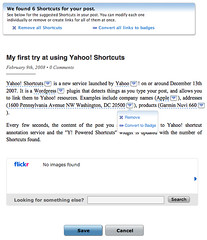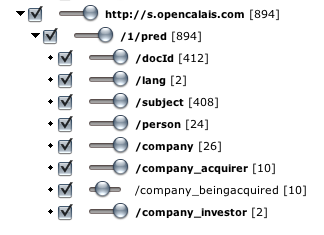Having both a background in the business and engineering of software, a topic of particular interest to me is the archetype or pattern of successful Web businesses. By “business platform”, I mean the software that powers a business and what I want to talk about is what the business platform typically does at highly successful Web businesses.
Archetypes or patterns are not synonymous with recipes. Knowing the typical structure of a symphony does not make you a composer, or in the present case, knowing the archetypal business platform does not make you a billionaire. They do nonetheless help you in thinking and exchanging ideas about particular instances.
Ok, I won’t make you salivate longer. Here’s my attempt at formulating the archetypal business platform on the Web:
“Web companies make it easy for people to post information on the Web in a format that makes it easy for other interested people to discover, search and browse what is relevant to them, but more importantly in a way that they retain control over who gets to see the information and how. All that of course, 24/7, real-time and globally.”.
Let’s take a few examples:
- YouTube made it easy for people to post videos on the Web in a format that makes it easy for other interested people to discover, search and browse what is relevant to them, but more importantly in a way that they can add commercials to the videos being watched.
- Facebook made it easy for people to post status, pictures, messages, review, etc. in a format that makes it easy for other people to discover, search and browse those that are relevant to them (their friends’), but more importantly in a way that they can track who is interested in what and add relevant “social ads” next to the information they consume.
- Amazon started as an online bookstore, but is quickly evolving into making it easy for book writers, audio book producers and possibly in the near future vendors of other types of digital or potentially digital goods to publish their work on the Web, in a way that makes it easy for other interested people to discover, search and browse (Kindle), and buy, but more importantly in a way that they can take a commission on the resulting purchase transaction.
- Apple started as a hardware vendor, but it has quickly become a company involved in making easy and safe for music and movies producers (soon game producers) to market their digital goods online in a way that other people can easily listen to or watch (iPod, AppleTV, etc.), but more importantly in a way that they can take a commission on the resulting purchase transaction (iTunes).
- etc.
Ok, I am assuming that by now I’ve convinced you, or that I got the benefit of the doubt, or at least that I formulated correctly something that has long been obvious for you (and that you can now share easily). If not, I’m happy to learn about your viewpoint and discuss.
What is now interesting to think about, is how we can take this simple tool in thinking about the future of business on the Web. I think we can make a few easy predictions:
- Autonomous publishing software/hardware that publish information about you on their own are quite exciting, as enablers of new businesses. Example includes your location as detected by your cell phone provider, temperature/humidity data loggers (ex. temperature, humidity) used to complement existing weather sytems, 2-way navigation systems used for real-time traffic data sharing, camera that directly push pictures on the Web, etc. I think we will see more of these autonomous data publishers.
- Publishing tools that will make it easier for people to write content in a format that can be indexed, searched, browsed by others. Here, we may finally start to move away from the online form and start to see semantic extraction technologies or semantic content editors that add unambiguous meaning (microformats in the case of text) to your content as you create it.
- Consumption interfaces that will make it easier and entertaining for people to express what they are looking for in a way that a software can understand and find relevant items from an ever growing and diverse collection of digital goods.
- Consumption devices that will provide the best way possible to experience a content in a given environment. That would include screen walls for digital painting, 3D printers, etc.
(Please use the comment form to submit your ideas)
Of course, last, we will see more and more of companies trying to own the whole chain on a particular type of digital good or a particular community of people, via acquisitions or partnerships. And to mirror this, more and more communities that will try to prevent companies from doing so too much and/or for too long.
Again, this archetype is not a recipe for success. In my view, the most significant pattern of success but also the most difficult to craft is community. Another one is legal innovation. More on both, hopefully, later.








